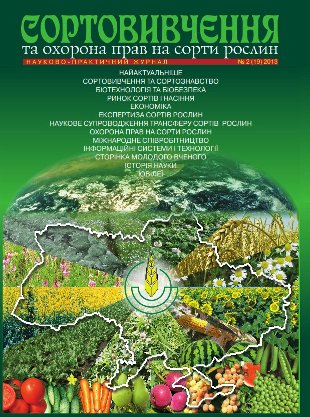Response of soft winter wheat (Triticum aestivum L.) to longtime enforced dormancy and time of spring vegetation recommencing
DOI:
https://doi.org/10.21498/2518-1017.2(19).2013.58541Keywords:
winter wheat, ecological factor, induced dormancy, vegetation restart, variety, yield, growth, development, survival, temperature, moisture supply.Abstract
The article highlights the results of studying the soft winter wheat response to the duration of enforced winter dormancy and the time of vegetation recommencing, their impact on growth, development and the survival of the crops. It is found that the impact of those factors in the conditions of central Forest-Steppe of Ukraine is essential, which is to be taken into consideration when scheduling the measures of spring and summer care over the cultivated crops, in particular, where the spring extra nutrition takes place, pesticides and growth regulators are applied, the spaced planting resowing or partial resowing issues are to be settled down. The ecological effect of spring vegetation recommencing dates does not expose annually, therefore it is not always possible to predict the plant development type, but it is possible, nevertheless, to influence the processes of growth, development and survival of plants throughout spring-summer period and the development of their production capacity by means of introducing the intense technologies, optimization of mineral nutrition and the use of plant growth regulators, protection from rogues, diseases, pests.Downloads
References
Мединец, В.Д. Влияние экологических условий и времени возобновления весенней вегетации растений на соотношение органов и продуктивность пшеницы озимой, их значение для сортовой агротехники и селекции: автореф. дисер. на соиск. учен. степени доктора с.-х. н. – Харьков, 1974. – 48 с.
Мединець, В.Д. Природні стресори в онтогенезі зимуючих рослин / В.Д. Мединець // Управління онтогенезом рослин. – Полтава: Верстка, 2001. – С. 23–49.
Госагропром СССР. Методические рекомендации по разработке дифференцированного ухода за посевами озимых культур в зависимости от ВВВВ при интенсивной и обычной технологиях возделывания. Автор Мединец В.Д. – Полтава, 1986. – 22 с.
Методика проведення експертизи та державного випробування сортів рослин зернових, круп’яних та зернобобових культур // Охорона прав на сорти рослин: Оф. бюл. – К.: Алефа, 2003. – Вип. 2. – Ч. 3. – 241 с.
Улич, О.Л. Продуктивність сортів пшениці озимої залежно від попередників і строків сівби в правобережному Лісостепу: автор. дис. на здобуття наук. ступеня канд. с.-г. наук. – К., 2006. – 20 с.
Литвиненко, М.А. Вплив строків сівби і сублетальних зимових температур на виживаність та врожайність пшениці озимої / М.А. Литвиненко, С.П. Лыфенко // Вісник аграрної науки. – 2004.– No 5. – С. 27–31.
Селекція пшениці озимої на адаптацію до біо- та абіотичних чинників та якість зерна / Спеціальна селекція і насінництво польових культур. За ред. В.В. Кириченка. – Харків, 2010. – С. 29–44.
Клуб 100 центнерів // Сорти та оптимальні системи вирощування пшениці озимої. – Видання 7. – К.: Логос, 2012. – 132 с.
Downloads
Published
How to Cite
Issue
Section
License
Copyright (c) 2013 Ukrainian Institute for Plant Variety Examination

This work is licensed under a Creative Commons Attribution-ShareAlike 4.0 International License.
Starting in 2022, the copyright to the publication remains with the authors
Our journal abides by the CREATIVE COMMONS copyright rights and permissions for open access journals.
Authors, who are published in this journal, agree to the following conditions:
- The authors reserve the right to authorship of the work and pass the first publication right of this work to the journal under the terms of a Creative Commons Attribution License, which allows others to freely distribute the published research with the obligatory reference to the authors of the original work and the first publication of the work in this journal.
- The authors have the right to conclude separate supplement agreements that relate to non-exclusive work distribution in the form in which it has been published by the journal (for example, to upload the work to the online storage of the journal or publish it as part of a monograph), provided that the reference to the first publication of the work in this journal is included.

























 Ukrainian Institute for Plant Varieties Examination
Ukrainian Institute for Plant Varieties Examination  Селекційно-генетичний інститут
Селекційно-генетичний інститут Institute of Plant Physiology and Genetics of the National Academy of Sciences of Ukraine
Institute of Plant Physiology and Genetics of the National Academy of Sciences of Ukraine
 The National Academy of Agrarian Sciences of Ukraine
The National Academy of Agrarian Sciences of Ukraine